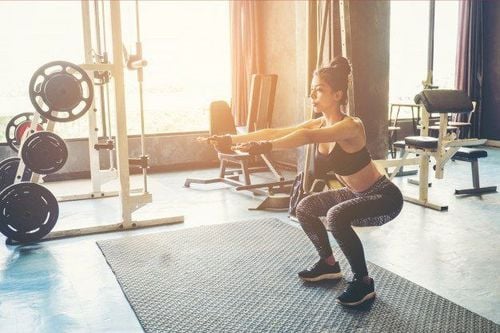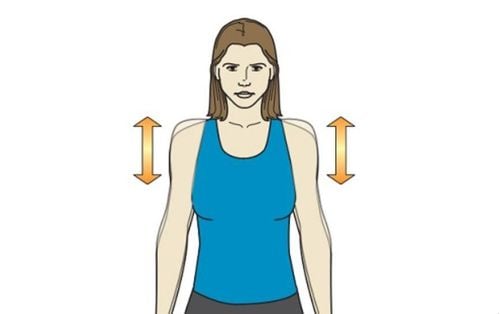No matter how intense you squat, breathing technique is crucial to ensure safety and effectiveness of your workout.
1. How to breathe while squatting
Breathing while squatting is a two-step process:
- Firstly, you need to take a deep breath and put pressure in your abdominal cavity.
- Secondly, you need to brace your core as hard as possible by expanding your torso in a 360-degree angle to create stiffness and strength. By using this technique, you can reduce the pressure on your spine, keep you safe, and allow you to lift greater weights when squatting.
Before performing the squat movement, synchronizing the order of breathing steps should be prioritized. The two steps of the breathing process while squatting can be abbreviated as "2B". The first "B" is "Breath", and the second "B" is "Brace", which means firmness.
Step 1: Deep abdominal breathing
In the 2B system, the first B stands for "BREATHE". At first, the athlete takes a large breath with their belly, using the diaphragm. Our diaphragm is a dome-shaped muscle that separates the thoracic cavity from the abdominal cavity. Once you know how to breathe with your diaphragm, the next step is to create as much tension in your abdomen as possible. Breathing this way allows athletes to show strength and protect themselves by amplifying intra-abdominal pressure. Applying diaphragmatic breathing leads to vacuum effect, drawing air into the lungs and increasing abdominal pressure. High pressure increases trunk stability, thereby protecting the spine because it does not move much during exercise. This is the goal of squatting, and we never want to create even minor injuries to the spine. However, sometimes excessive intra-abdominal pressure can cause nosebleeds.
Step 2: "BRACE" and create as much tension as possible
In the 2B system, the second B stands for "BRACE", which means firmness, referring to self-protection from an impending impact. Imagine someone is about to poke your stomach with a baseball bat or you're about to get a body check in hockey. The natural tendency is to tense your body to protect yourself. If you don't brace properly, you can lose stability in the lower part of the squat.
Here's a simple exercise you can do:
- Start by wrapping your arms around your waist with your thumbs on your lower back and the other fingers on the sides and front of your abdomen.
- From this position, gently apply pressure to your abdomen and then start breathing. If you breathe with your diaphragm correctly, you will feel a 360-degree expansion around your trunk.
- Apply the second B and feel the tension of the tissues increase. You should NOT feel your waist getting smaller so push out, don't suck in.
- This can also be done with an exercise band and a training partner. Wrap the band around your trunk and have your partner pull the band. Then the trainee performs the 2B technique, breathing and bracing. They will receive visual feedback from their training partner to confirm if they are doing it correctly.
It is important to note that for optimal results, both parts of the 2B system must be performed correctly and in the proper order. If this process is done in reverse order and the athlete braces before breathing, it will limit the amount of inhaled air. This not only reduces the effectiveness of squatting but can also cause spinal injuries.

2. Do's and don'ts of breathing while squatting
If you follow the 2B synchronized system, intra-abdominal pressure will increase first, then spinal stiffness will be created by tension. This keeps the spine in its natural position throughout the lift.
When the spine is not loaded for a weightlifting squat, it supports the flexible movement of the trunk. However, after applying the 'breath and brace' technique, the spine will become a fixed bar. Thanks to that, the limbs around the spine can exert maximum strength.
It is important to understand that even when the spine becomes a fixed bar after performing 2B, it will still have a normal physiological curve.
The goal of squatting is to maintain this normal curve while performing the squat. How do we achieve this? By 'breathing' and 'bracing', then keeping the hips low and the chest pulled down.
The sign of "lowering the ribs" allows us to brace even harder after breathing, and it also prevents excessive spinal extension (arched back).
You may have seen people squat by sticking their buttocks out and their chest out like a bird. These positions can cause the spine to move out of its normal position when under load. When the spine moves under load due to ineffective breathing and bracing, conditions such as herniated discs, fractures, or even joint laxity can occur due to excessive arching during squats. Joint laxity or excessive movement in a segment (too much movement) reduces spinal stability, reduces abdominal pressure, and makes you weaker, unable to lift at the highest intensity.
3. The habit of holding breath while squatting
If you hold your breath while squatting, this is called the Valsalva maneuver. This phenomenon occurs in everyone when we cough, sneeze, vomit, or defecate. During squats, a similar technique can be performed, which amplifies the 'breathing and bracing' technique.
However, holding your breath can increase intra-abdominal pressure excessively, which can also lead to a sudden increase in blood pressure. Therefore, if an athlete has high blood pressure, they should consider and consult a specialist before performing this technique.
To arrange an appointment, please call HOTLINE or make your reservation directly HERE. You may also download the MyVinmec app to schedule appointments faster and manage your reservations more conveniently.
To arrange an appointment, please call HOTLINE or make your reservation directly HERE. You may also download the MyVinmec app to schedule appointments faster and manage your reservations more conveniently.








